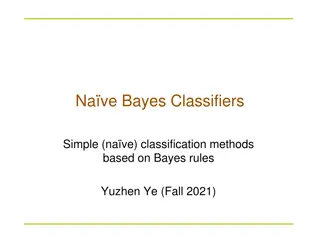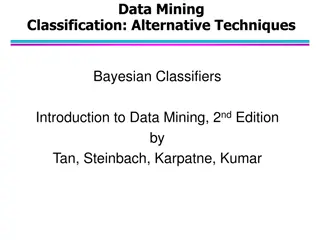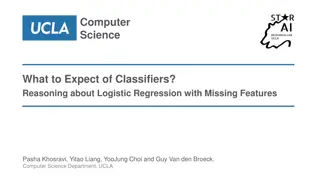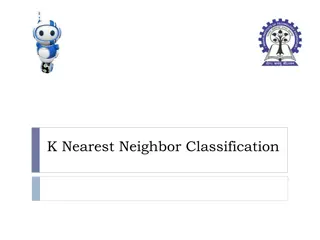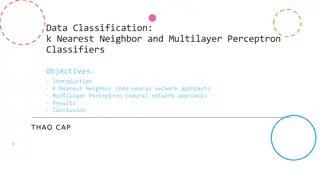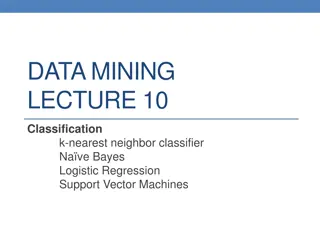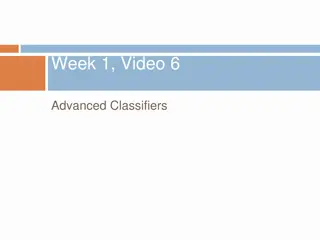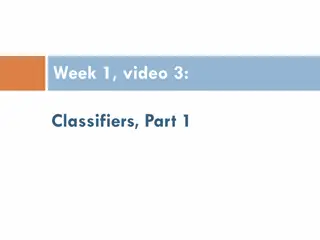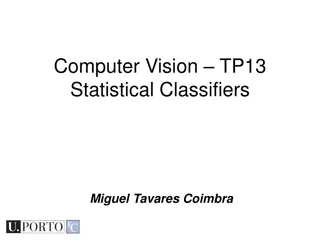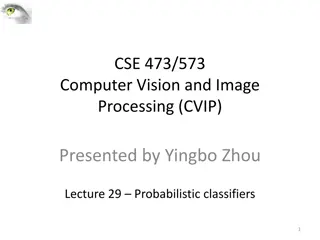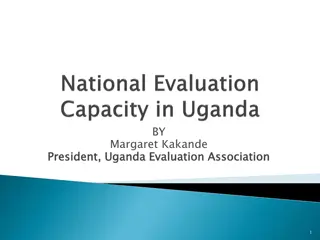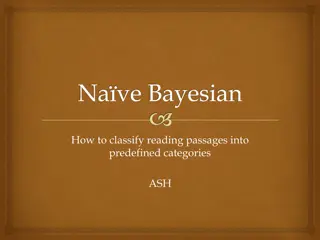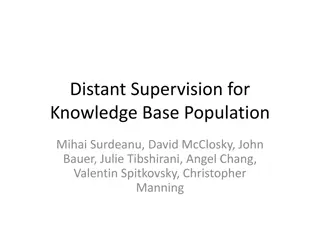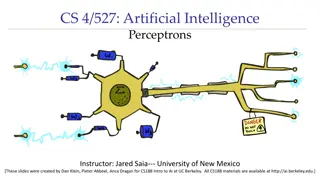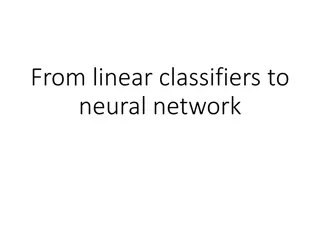
Predictive Analytics in Economics
Explore the importance of predictive analytics for economists in the field of economics, focusing on judging classification performance, evaluation methods, and classification matrices. Understand how classifiers are assessed based on available information and problem nature, with an emphasis on optimizing outcomes for better decision-making. Dive into the intricacies of classification matrices to interpret predicted and actual values effectively.
Download Presentation

Please find below an Image/Link to download the presentation.
The content on the website is provided AS IS for your information and personal use only. It may not be sold, licensed, or shared on other websites without obtaining consent from the author. If you encounter any issues during the download, it is possible that the publisher has removed the file from their server.
You are allowed to download the files provided on this website for personal or commercial use, subject to the condition that they are used lawfully. All files are the property of their respective owners.
The content on the website is provided AS IS for your information and personal use only. It may not be sold, licensed, or shared on other websites without obtaining consent from the author.
E N D
Presentation Transcript
Eco 6380 Predictive Analytics For Economists Spring 2016 Professor Tom Fomby Department of Economics SMU
Presentation 9 Judging Classification Performance In the Absence of Payoff Matrix See Chapter 5 in SPB
Note: In the discussion that follows we are going to take the data partition sequence to be Training Data Set, then Validation Data Set, and, finally, the Test Data Set (the SAS EM and XLMINER Convention)
Evaluation Methods are Dependent on Available Payoff Information and the Nature of the Problem at Hand. Here we assume no specific purpose for the classifier (like application to a Target Marketing Problem) Case I: Base the Performance of the Classifier on the Scoring of an Entire Hold-out Sample with no knowledge of the Payoff Matrix (This Power Point Presentation) Case II: At Least Some Information is known about the Payoff Matrix and the Classifier is chosen to maximize Payoff. (Next Power Point Presentation)
Classification Matrix Predicted Value 1 0 False Negative (Type I Error) 1 True Positive Actual value False Positive (Type II Error) 0 True Negative
Classification Matrix with Outcomes on a Hold-out Sample ???= ?????? ?? ????? ????????? ?????????? ?? ?? ???= ?????? ?? ????? ????????? ?????????? ?? ?? ???= ?????? ?? ? ? ????????????? ?? ? ? ???? ? ????? ???= ?????? ?? ? ? ????????????? ?? ? ? ???? ?? ????? ? = ???+ ???+ ???+ ???= ?????? ?? ????? ?? ???? ??? ?????? ??? =???+ ??? ? ??????????? = ???+ ??? ??????????? = ???+ ??? = ???????? ???? ??? = ?????????? ?? ????????? ?????????? ????????? ??? = ?????????? ?? ????????? ?????????? ????????? Predicted Value 1 0 1 n11 n10 Actual value 0 n01 n00
Classification Matrix with Outcomes on a Hold-out Sample Predicted Value 1 0 1 n11 n10 Actual value 0 n01 n00
The Nave Classifier It is based on a random classifier whose rating of cases is uninformative. That is, f(r >= t|y=1) = f(r >= t|y=0). The probability of the rating (r) of a positive=1 subject exceeding the chosen threshold t is equal to the probability of the rating probability of a negative=0 subject exceeding the chosen threshold t. Therefore, the ROC curve of the random (na ve) classifier coincides with the 45-degree line in the ROC diagram. Note that the Na ve Classifier is a benchmark in the sense that it does not use any of the characteristics of the case to classify the case.
Receiver Operating Characteristic (ROC) Curve: Shows the Relationship between Sensitivity and the False Positive Rate as a Function of the Threshold Value Used by the Classifier. The Dashed Line represents the Na ve Classifier which does not use a Threshold Value.
Tracing Out the ROC Curve for One Classifier as a Function of Threshold (Cutoff Probability) Note: A Perfect Classifier Would Produce the Point (0,1.0) in the ROC Diagram (upper left-hand corner). Strict Threshold means a high cutoff probability for classifying a case as a success (y = 1). Lax Threshold means a low cutoff probability for classifying a case as a success (y=1). If a case has a probability greater than the threshold, we classify the case as a success (y=1). Otherwise, we classify the case as a failure (y=0). FPF = False Positive Fraction = FPR = False Positive Rate. TPF = True Positive Fraction = TPR = True Positive Rate.
The Threshold Determines the Trade-off Between Committing a Type I Error (False Negatives) and a Type II Error (False Positives). If the Probability of a case exceeds the threshold, we classify the case as a 1, otherwise as a 0. As the Threshold approaches one, we find that the sensitivity of the classifier will be zero while the specificity will be one. (See the (0,0) point on the ROC curve.) As the Threshold approaches zero, we find that the sensitivity of the classifier will be one while the specificity will be zero. (See the (1,1) point on the ROC curve.) The ROC curve is then traced out by decreasing the threshold from 1.0 to 0 as you move from the (0,0) point in the lower left-hand corner of the ROC diagram to the (1,1) point in the upper right-hand corner of the diagram. Therefore, as the threshold becomes more strict (higher), we expect the Type I Error (false 0 s (negatives)) to occur more frequently while the Type II Error (false 1 s (positives)) would occur less frequently. Of course, with a lax (low) threshold you would expect the Type II Error to be more prevalent and the Type I Error to be less prevalent.
Training versus Test Data Set ROC Curves for One Classifier Here we are comparing the areas under the ROC Curves. Should be making Classifier Comparisons Across Test Data Set ROC Curves to Avoid Over-Training
Confidence Intervals can be put around a given ROC Curve as in the below figure. However, when making ROC comparisons across Competing Classifiers, this is usually not done.
A Comparison of Four Different Classifiers with the Na ve Classifier (the dashed line). The ROC Curves should be based on the Test Data Sets. The Best Classifier has the Largest Area Under the ROC Curve.
Euclidian Distance Comparison of ROC Curves Another way of comparing ROC curves is to compare the minimum distance between the perfect predictor point (0,1) with a point on the ROC curve of the classifier.
A Euclidian Distance Measure Let ????,???? be a point on a ROC Curve. The minimum distance ROC point, (??? ,??? ), is the point on the ROC Curve that is closest (in Euclidian distance) to the ideal classifier point, (0,1). This distance is given by ? = ????[(???? 0)2+ (???? 1)2] = ????[????2+ ????2 2????+ 1]. A measure of the goodness of a classifier via its ROC curve that has been proposed is ? 1 ???2+ 1 ? ???2= 1 ??. W is a positive weight such that 0 < ? < 1 and represents the user s view of the relative cost (W) of False Negatives (Type I Errors) versus the cost (1 W) of False Positives (Type II Errors). In the absence of any knowledge on these relative costs one can choose W = 0.5 (??= ?) in the belief that the two costs are approximately equal to each other. Obviously, this measure varies from ???= 0 (a poor classifier) to a perfect classifier when d = 0 and ???= 1. So the closer the ???measure is to one, the better the classifier is by this measure. Then comparing across classifiers, the classifier with the maximum ???over all classifiers when scored over the TEST DATA SET is the preferred classifier. ???= 1
Caveat of the ???Measure The ???measure of classifier accuracy seems to be a little less satisfying than the area measure since the ROC curve characterizes the classifier performance for all possible values of the Threshold, not just the Threshold, say ? , that is implied by the minimum Euclidian distance point (??? ,??? ) on the ROC Curve. Who is to say that the implied Threshold, ? , of the minimum distance point, (??? ,??? ), is the optimal threshold point for the problem at hand? Optimal threshold values can only be determined when there is information available on the Payoff Matrix. See later discussion on Classifier Choice using the Payoff Matrix.
What a Test Data Set ROC Curve Might Look Like for One Classifier using a Finite Number of Thresholds (To get the area under the empirical ROC Curve, one has to sum up approximating rectangles)
An Example of Empirical ROCs for Four Classifiers
Summary: ROC Curves The areas under Test Data Set ROC Curves can be used to compare the performances of competing classifiers when considering the entire hold-out data set. The Classifier with the largest area under its Test ROC curve is the preferred classifier. The ROC curve s primary usefulness comes in the case where nothing is known about the Payoff Matrix associated with the Classification Problem at hand. We now turn to studying cases where we know something about the Payoff Matrix.

